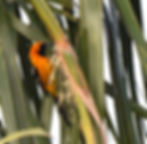In pursuit of the spring nectar
- jjvanm
- Apr 5
- 4 min read
Published in the McAllen Monitor April 5, 2025.

Story and photos by Anita Westervelt
After last week’s severe thunderstorms had passed, the wind had stilled yet the flowering branches of a tree were bobbing up and down one morning. I snagged the binoculars, took a quick look, then grabbed the camera. I managed a none-too-clear shot through a window of a female hooded oriole, drinking nectar from a bloom on a coral bean tree, Erythrina herbacea.
A week earlier, I had caught a male and female hooded oriole grasping stalks of a blooming aloe vera plant, pushing their beaks into the tubular flowers for nectar as the birds circled the flower cone.

Hooded orioles are spring and summer residents of the Rio Grande Valley, arriving around mid-March to set up breeding territories.
After taking the photo through the window, I ventured outdoors, close to the coral bean tree, hoping the bird would return. Instead, I scared her off when I rounded the corner of the house. She had been in a cape honeysuckle vine, Tecomaria capensis, that was trellised at the side of the house. I backed away and sat out of sight to wait her out, focusing the camera on the coral bean.
Just as I was thinking I might be sitting there all day, waiting for another photo opportunity, a bright orange male hooded oriole sallied over to a Mexican fan palm, Washingtonia robusta, that towers above the coral bean. He gleaned insects from the palm fonds and appeared to take a stab at the palm blooms, possibly for nectar. He finally arrived at the coral bean and actively pursued drinking nectar from the base of the flowers.



I shouldn’t have been surprised at the oriole’s feeding mannerisms. I have photographed hooded orioles, tapping into the nectar of Turk’s cap blooms, Malvaviscus drummondii. At some flowers, hooded orioles get nectar by piercing the base of the flower, an action that does not assist in pollination and has labeled them as nectar robbers. Their diet also consists of spiders, and insects such as flies, ants, beetles, grasshoppers, larvae and caterpillars.
Of the plants mentioned in this spring blooming tale, coral bean and Turk’s cap are native in the Rio Grande Valley. Coral bean has a large native range throughout the southeastern United States and northeastern Mexico. It is a thorny shrub about six feet tall; blooms come out in spring, before the leaves. The flowers are a big draw to hummingbirds and apparently, hooded orioles.

Cape honeysuckle is native to tropical southern Africa. It is not a true honeysuckle; it is named for the Cape of Good Hope. It is noted to be irresistible to hummingbirds and orioles. Although not native here, Cape honeysuckle is a close relative to trumpet creeper, also known as trumpet vine, Campsis radicans, which is synonymous with Tecoma radicans, meaning they are considered tropical cousins. Trumpet vine is native to East Texas.
Aloe vera, is an aloe native to the south-east Arabian Peninsula and now widely cultivated and naturalized in the Rio Grande Valley, where it is a significant agricultural crop.
Texas Master Naturalists promote using plants native to the Rio Grande Valley in home gardens. We realize that not all plants in lon-established residential gardens are native. As evidenced in my yard recently, birds, as well as butterflies and other insects, need to survive and will use plants that are available.
Introducing native plants into established gardens is a step toward helping the native footprint of the Valley.
Members of the South Texas Border Chapter, Texas Master Naturalist organization will sell native plants at their booth at the Rio Grande Valley Home and Garden Show at the McAllen Convention Center, April 11 – 13. They will be available to talk about the native plants and answer visitors’ questions.
Chapter members also will give presentations promoting the value of adding native plants to home gardens. Following is the Texas Master Naturalist’s speaking schedule.
April 11, at 3:45 p.m., “Butterfly Gardening with Native Plants” presented by Stephanie Lopez, executive director of the National Butterfly Center in Mission, Texas.
April 12, at 2:30 p.m., “Native Plants for Year-Round Blooms” by Anita Westervelt, McAllen Monitor nature newspaper columnist.
At 3:30 p.m., “Better Lights, Safer Nights,” by Jennifer Rektorik, DarkSky International Advocate.
April 13, at 2 p.m., “Drought Resilient Plants for the Rio Grande Valley” by John Brush, Quinta Mazatlán’s Urban Ecologist.
At 3 p.m., “Disappearing Rare and Native Plants of the Rio Grande Valley,” by Eric Luebanos, owner of The Sixth Street Garden Sanctuary for endangered species.
For more information about the show, visit rgvhomeshow.com.
- 30 -
